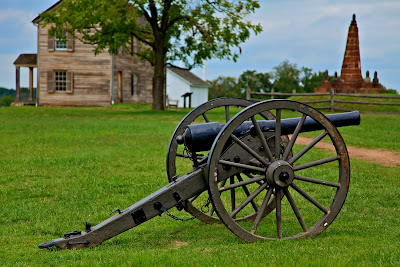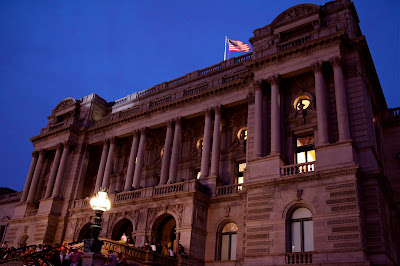I went to Manassas on two different days to tour Manassas National Battlefield Park, see Civil War demonstrations, and walk around Manassas Old Town several miles away.
Two Battles On This Field
In the First Battle of Bull Run in July 1861 (called First Manassas by the Southern side), green, unbloodied armies on both sides were staggered by the brutal reality of war and suffered 900 killed and 4,600 casualties between them.
What initially looked like a Union victory turned instead into a rout of the Northerners, with the Federals fleeing headlong back to the defenses of Washington.
A year later, the Union army would be baited into fighting a much larger battle on roughly the same ground.
At Second Manassas, Federal and Confederate troops would slug it out grimly toe to toe, with 2,000 of 7,000 troops engaged falling within a single multi-hour exchange of broadsides in the open fields at Brawner's Farm at the opening of the battle.
The 22,000 total casualties at Second Manassas would be a bloody prelude to the carnage at Antietam just 2 weeks later, when 23,000 Americans would fall in a single day.
Manassas National Battlefield
First Manassas is easier to understand than the second battle, because it was largely concentrated on Henry Hill, where the Visitor Center is sited today. From those heights you can see almost all of the places where the action took place as the Union troops attacked in a flanking action from the north along Sudley Road.
It was on Henry Hill, named after the Henry family whose farm was located here and whose house lay in the thick of the action, that Confederate General Thomas J. Jackson would earn the sobriquet by which he would be known to history.
As Confederate troops wavered and retreated under the Union onslaught, General Barnard Bee of South Carolina shouted before being killed, "There stands Jackson like a stone wall! Rally behind the Virginians!"
A giant equestrian statue of Stonewall Jackson stands today near the spot where his lines faced the Federals and stemmed the tide, leading to ultimate Southern victory on the battlefield.
Second Manassas
In contrast, the action of Second Manassas stretched over a 10-15 mile area, with the first engagement occurring at Brawner's Farm about 5 miles west of Henry Hill.
It was here that Jackson's troops attacked Federal troops moving toward Washington on August 28th after Jackson's raid on the federal depot at Manassas Junction abruptly forced Union General John Pope to pull his lines back from the Rappahannock River.
Pope mistakenly thought he had cornered a retreating Jackson and poured troops into attacking strong defensive positions, while ignoring the arrival of a large second Confederate army under James Longstreet.
On August 30th Longstreet's army attacked, and only stubborn Federal rearguard actions saved the Union army from the ignominious flight of the year before, or perhaps even total destruction.
Touring the Battlefield
Visitors are supposed to check in at the Visitor Center on Henry Hill to pay the low $3 park fee. It's a great place to get an overall understanding of the battle and the weapons and tactics, though the focus is largely upon the first battle.
There is a large topographical map in the small museum with lights showing the troop movements at First Manassas, and an excellent 45-minute film that explains the circumstances around both conflicts.
The topographical map of the second battle, however, is located at Brawner Farm, where Second Manassas started about 5 miles west of the Henry Hill Visitor Center.
From the windows of the Visitor Center, you can peer out at the reconstructed Henry House which was blown to bits during the first battle, and see the line of guns where the Federal artillery battery faced Stonewall Jackson's troops.
Visitors can take self-guided tours along the many walking trails or in their cars, or take guided tours with park rangers.
Civil War Events
Infantry, cavalry, and artillery demonstrations were held at Brawner's Farm during the Second Manassas anniversary, and it was here that I learned that it is National Park Service policy not to hold large-scale re-enactments on Park Service land (with rare exceptions).
The centennial re-enactment of the First Battle of Bull Run in 1961 resulted in a number of injuries, large amounts of trash, and damage to the grounds, so policy was changed to treat these battlefields as memorials -- hallowed ground -- with only small-scale tactical demonstrations. The Second Manassas re-enactment was actually held somewhere in Pennsylvania this year.
It was sobering to read the plaque at Brawner's Farm a hundred yards from the demonstrations, and realize it was placed along the line where long rows of Union dead lay fallen in their ranks after point-blank exchanges with the Confederates.
I've attended the re-enactment at the Battle of Cedar Creek held on the actual battlefield, but apparently that park is owned and maintained by private non-profit organizations.
Old Town Manassas
Manassas' significance during the Civil War was a result of its location across the junction between two railroad lines, making it an important supply point and the fastest way to travel to the Shenandoah Valley to the west and Confederate capital Richmond to the south.
Federal movements to seize Manassas Junction led to the first battle, and Jackson's destruction of the Federal supply base at Manassas precipitated the second. (The Confederates had abandoned Manassas earlier in the year.)
Today the city's visitor center is located in a 1914 rail station and commuters still catch the train from this complex. Though the Civil War-era buildings are mostly gone, you can walk around the picturesque Old Town and visit the Manassas Museum across the street.
The Final Word
About 20% of the men who served in the Civil War died (though two-thirds from disease), and countless others were maimed. I find it incredible that these men would march into battle against those kinds of odds, using tactics 20 years out of date against newly deadly weaponry.
In many of the pitched battles, a third of the men on both sides were casualties.
At First Manassas, they went in as innocents, but by the time of the Second Battle of Bull Run, they knew full well the horrors of war, yet stood steadfast anyway.
Whether it was because they believed in a cause or simply had no other choice, that kind of bravery has to be respected.
Getting There
Manassas National Battlefield Park occupies 5,100 acres to the north of I-66. Take exit 47B north (Sudley Road/SR 234) and follow the sign to the Henry Hill Visitor Center to start your tour.
Much of the park runs along the axis of US 29 (Lee Highway), the former Warrenton Turnpike which led to Washington and along which General Pope's men were traveling when attacked by Stonewall Jackson at the beginning of Second Manassas. Brawner's farm lies just north of US 29 at the western end of the park.
The large park has many trails for hikers and horseback riders.
Old Town Manassas is about 6 miles south of the park. You can follow Sudley Road to either Grant Avenue or Centreville Road (Route 28) and from there to the Amtrak train station where the visitor center is located. 4-hour parking is available on weekdays in several lots or the parking garage (the limit primarily affects commuters taking the train), and is unrestricted nights and weekends.
Manassas National Battlefield Park
12521 Lee Highway
Manassas, Virginia 20109
Henry Hill Visitor Center
6511 Sudley Road
Manassas, VA 20109
Hours of Operation:
The park is open daily from dawn to dusk.
The Visitor Center is open daily from 8:30am to 5:00pm. Closed on Thanksgiving and December 25.
Fees:
3-Day Pass: $3 (children under 16 are free)
Annual Pass: $20
Annual Pass for All NPS Parks: $80
 Read the Full Post
Read the Full Post





























































